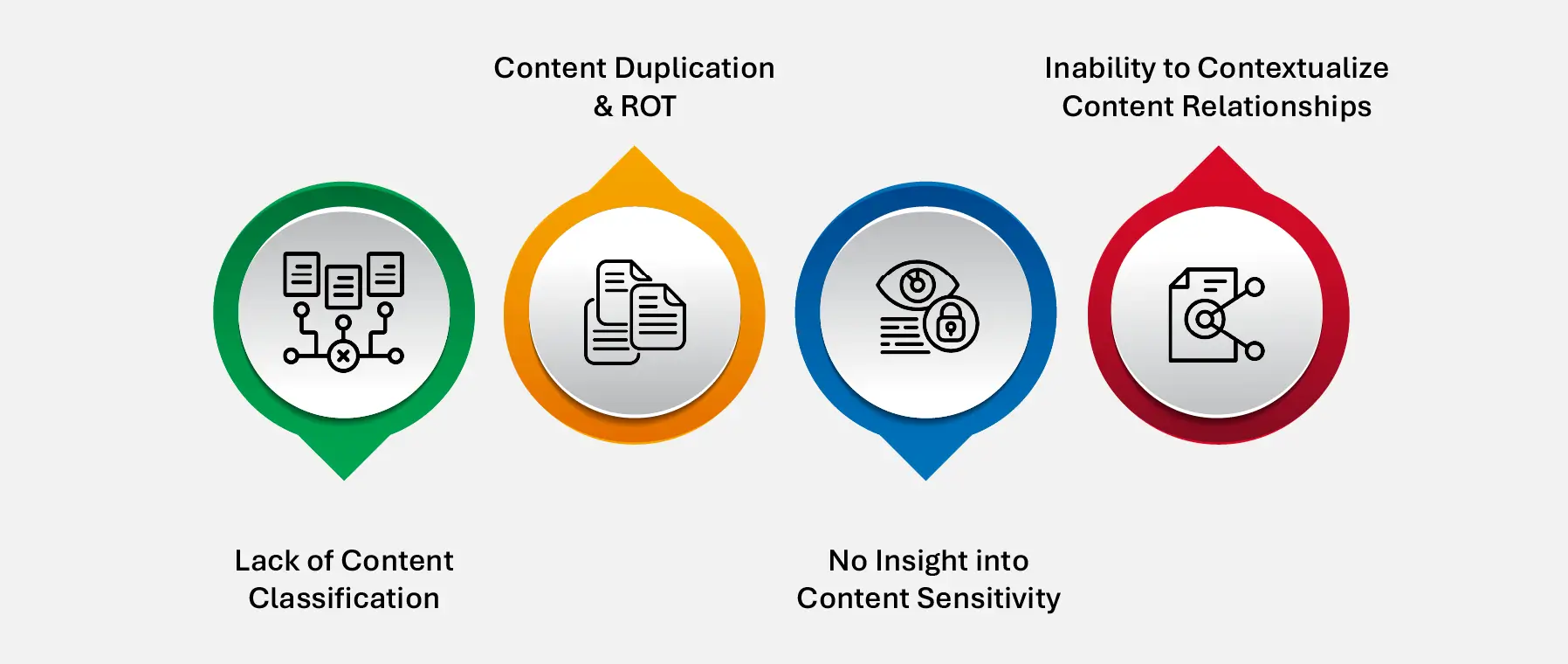What is Content Analytics?
Content Analytics is the process of systematically analyzing digital content, such as text, images, videos, and other media—to extract meaningful insights that can inform decision-making, improve content strategy, and enhance user engagement. It leverages a blend of Artificial Intelligence (AI) / Machine Learning (ML) and Natural Language Processing (NLP) to provide comprehensive content analysis for business-sensitive and Personally Identifiable Information (PII) data. By discovering, classifying, and remediating sensitive information, we enable enterprises to make informed decisions around data security, compliance, and overall data management.
Think of it as intelligence for your files, documents, emails, and media. Content analytics identifies what kind of data you have, where it lives, who’s using it, what it contains, and how it relates to other content—unlocking value and visibility across the organization.
Why It Matters in Today’s AI Era
We’re in the midst of a content explosion. From employee-generated documents and contracts to scanned forms, chat logs, videos, and voice notes—organizations are generating unstructured content at unprecedented rates. But here’s the catch: 80–90% of this content often sits untouched, unclassified, and ungoverned.
That’s a major blind spot.
In an AI-driven world, where content often feeds decision-making algorithms or serves as input for customer-facing applications, having clarity into your content is non-negotiable. Without proper analysis, organizations risk storing outdated, duplicate, non-compliant, or sensitive content in the open—fueling inefficiencies and potential violations.
Content analytics not only identifies and classifies what you have, but it also enables smarter automation, improved compliance, optimized storage, and better AI model training by delivering context-rich, accurate insights from across your digital landscape.
The Visibility Challenge with Enterprise Content

Despite investing in repositories and collaboration tools, most organizations still struggle to understand the content they manage. The root causes are clear:
- Lack of Content Classification:
Files are often stored without consistent metadata, making them difficult to search, group, or analyze. This limits reuse and increases the risk of compliance violations. - Content Duplication & ROT (Redundant, Obsolete, Trivial):
Without ongoing analysis, duplicate and outdated content piles up—consuming storage, inflating costs, and creating confusion over which version is “the truth.” - No Insight into Content Sensitivity:
Sensitive information like PII, PHI, or trade secrets may be hidden in everyday files and shared unknowingly. Without analytics, these risks remain invisible. - Inability to Contextualize Content Relationships:
A contract, an email, and a report may all be connected—but unless analytics links them, critical insights stay fragmented and siloed.
As content volumes grow across multiple departments and storage environments, enterprises face mounting operational, security, and compliance challenges:
- Shadow Content Proliferation: Employees create and store content across personal devices, email attachments, and cloud shares—often without governance. This untracked content increases security and privacy risks.
- Audit and Legal Risks: When audits or eDiscovery requests hit, enterprises scramble to locate relevant content. Without analytics, the search is manual, slow, and often incomplete.
- Ineffective Data Lifecycle Management: Without visibility into content age, usage, or business value, organizations retain everything, resulting in ballooning storage costs and poor data hygiene.
- Content Silos in Multi-Cloud Environments: Enterprises increasingly operate in hybrid and multi-cloud setups. Without unified analytics, content remains fragmented and unlinked, leading to missed insights and duplicated efforts.
How Content Analytics Helps Enterprises Solve These Challenges

- Brings Visibility to Dark Data: Automatically scans repositories, shares, and devices to surface previously unknown or untracked content—providing full visibility into your digital estate.
- Enables Proactive Risk Mitigation: Identifies and flags sensitive information exposure risks, such as credit card numbers in contracts or PII in files, before they trigger a breach or compliance failure.
- Streamlines Content Lifecycle Management: Tags content by age, redundancy, relevance, and usage—enabling smart archival, defensible deletion, and cost-efficient tiering strategies.
- Facilitates Faster Audit & Legal Response: Enables rapid identification of content matching legal hold, audit, or regulatory criteria, reducing response time and avoiding costly fines.
- Unifies Analysis Across Hybrid Environments: Offers a centralized view of enterprise content, even when spread across on-prem, cloud, and hybrid locations—bridging the gap between silos and turning scattered files into connected intelligence.
Content Analytics is more than just data discovery—it’s about turning digital clutter into strategic clarity. In today’s AI-fueled and regulation-heavy environment, organizations can’t afford to be blind to their content. With content analytics, you gain the power to classify, understand, and act on your data, making it secure, actionable, and aligned with business goals.
Getting Started with Data Dynamics:
- Learn about Unstructured Data Management
- Schedule a demo with our team
- Read the latest blog: Data Sovereignty 2.0: The Strategic Lever for Global Resilience and Innovation






